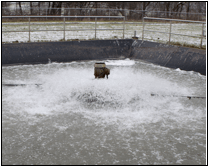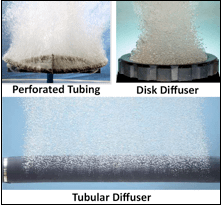
Food Industry Lagoon Aeration is critical to any industrial wastewater lagoon system. Food processing can be water-intensive and the resultant wastewater typically has high Biochemical Oxygen Demand (lagoon BOD). In this article we’ll outline the challenges facing food processing wastewater treatment, the problems that can occur, their causes, and then discuss food industry lagoon aeration options.
Food Industry Wastewater Challenges
Food industry wastewater typically has a very high lagoon BOD—up to 7,000mg/L or more, as compared to 250mg/L for an average municipal facility. In addition, lagoon BOD influents can be unpredictable, rising and falling with fluctuations in production or the change of seasons. Influent also typically includes a high level of organic solids, requiring turbulent mixing to promote efficient digestion and prevent sludge accumulation that can contribute to lagoon odor.Moreover, discharge compliance requirements are becoming increasingly stringent, and it’s not difficult to break permit of state regulatory agencies. Fines for violations can add up quickly—costly not only financially, but also to a company’s reputation and community goodwill. (If you’ve found us because you’re in violation, you can back into compliance fast with Triplepoint’s aeration rental.)
Food Industry Lagoon Aeration Problems
Wastewater treatment is not a priority for food industry facilities until it becomes a problem. Then it has the capability of impacting the bottom line through disrupting production, fines for discharge violations, and breaking operations and maintenance budgets.
Causes of Food Industry Lagoon Aeration Wastewater Problems:
-
Insufficient mixing causes sludge build-up, which reduces the lagoon’s holding capacity and treatment time and prevents the wastewater from being processed fully. This can lead to a spike in lagoon BOD effluent due to lack of treatment.
-
Insufficient oxygen leads to low levels of Dissolved Oxygen (lagoon DO). If there is not enough lagoon DO then the bacteria will not have enough oxygen to break down the BOD. This can lead to lagoon BOD effluent spiking, sludge buildup and stagnation, which can cause objectionable lagoon odors to develop.
-
Excess sludge reduces the aerobic performance of the lagoon, which leads to anaerobic treatment and odor. In addition, sludge can cause diffuser clogging. When diffusers clog and foul, backpressure will increase at the blowers, causing motors to work harder, consuming more energy or failing completely. This drives up operation and maintenance costs in addition to leading to problems resulting from low lagoon DO.
-
Failing equipment means inefficient and incomplete wastewater treatment, which can lead to fines and increased maintenance and energy costs.
An efficient, cost-effective food industry lagoon aerator must provide the following:
-
Proper Mixing. A food processing facility can discharge significant amounts of lagoon BOD and TSS into a wastewater lagoon, much in the form of solids. Robust mixing in the water column is essential to avoid the build-up of sludge, maximizing lagoon capacity and treatment efficiency.
-
Efficient Aeration. With unpredictable changes in BOD likely, maintaining a high lagoon DO is essential to ensure the bacteria always have enough oxygen to effectively break down the waste, which also reduces odor.
-
Flexibility. The system needs to run efficiently during normal times and be equipped to ramp up to handle fluctuations in BOD.
-
Low Maintenance. The system should be easy to install and maintain. With such substantial influent BOD levels, an aeration system cannot be offline for any amount of time or noncompliance may result.
There are two basic aeration options to retrofit a food industry wastewater lagoon: Surface Aerators and Diffused Aerators.
Surface Aerators
Surface aerators are one of the most often-used food industry lagoon aeration technologies.
Advantages of Surface Aeration (Pros)
-
Good in Shallow Water: The shallower the water, the more directly affected the entire water column can be.
-
Good in Rough Environments: These aerators are made of stainless steel and are heavily resistant to corrosive wastewater, which makes them resilient in extreme environments.
-
Portable/Easy Installation: Surface aerators simply float on the water with no subsurface mounting and are held by moorings attached to onshore anchors, making them easy to install and relocate.
Disadvantages of Surface Aeration (Cons)

-
Limited Mixing Performance: Surface aerators can really only mix the water in its immediate vicinity, so “dead zones” tend to develop where water stagnates, and sludge accumulates. The only way to increase mixing is to add additional aerators at an increased capital, operational, and maintenance cost.
-
Ineffective in Deep Water: Since the aeration takes place on the surface, they can only effectively mix the top 6–8 feet of water; the deeper water columns see little to no treatment, allowing solids to accumulate.
-
Inefficient Aeration: Independent testing facilities have shown surface aerators to transfer just 1.25–2.25 pounds of oxygen per horsepower hour. This is compared to diffused aeration systems, which can impart as much as 6–7 pounds/hp-h. As a result, Surface Aerators have higher power requirements and cost more to run.
-
High Maintenance Requirements: With many moving parts and motors on the surface of the water, the potential for breakdown increases. Mechanical aerators have a much higher malfunction rate than other systems, requiring more frequent maintenance and risking downtime, especially in cold weather.
(For more details, see Pros and Cons of Surface Aeration in Wastewater Lagoons).
Diffused Aerators
More efficient than surface aeration, diffused aeration has become increasingly popular. Coarse bubble systems mix water well, but because they don’t provide sufficient aeration have fallen out of favor and are not a retrofit option for food industry wastewater lagoons. Fine bubble diffused aeration systems are still a popular choice because of their ability to efficiently transfer oxygen to water.
Fine Bubble Aeration

A fine bubble lagoon diffuser aeration system, either secured to fixed laterals at the bottom of the lagoon or installed to floating laterals, releases tiny bubbles of 1–2 mm in size that slowly rise to the surface of the water. These thousands of tiny bubbles collectively have a very large surface area, and as a result, efficiently and effectively transfer oxygen to the entirety of the water column.
Advantages of Fine Bubble Aeration (Pros)
-
Improved Dissolve Oxygen Levels: Fine bubble aeration can achieve Standard Oxygen Transfer Efficiencies (SOTE) of 1.8–2.2% per foot of submergence, a performance that’s difficult to match with other systems.
-
Energy Efficiency: With its Standard Aeration Efficiency (SAE) of 4–7 lbs O2/hr/hp-wire, the fine bubble is far ahead of other technologies in terms of energy efficiency. In many cases, switching from alternative lagoon aeration technologies can save anywhere from 40–60% (or more) on energy costs.
-
Low Maintenance: Compared to surface aerators, fine bubble diffused aerators have fewer moving parts, with motors installed on-shore for ease of maintenance.
Disadvantages of Fine Bubble Aeration (Cons)
-
Insufficient Mixing: Fine bubbles are too small to disrupt or displace water in large volumes, and they rise too slowly to contribute to mixing. Over time this can lead to sludge buildup. Increased amounts of sludge result in less effective treatment overall, and eventually the costly process of removing sludge from the wastewater lagoon.
-
Fouling and Clogging: Any fine bubble aeration technology is susceptible to bacterial fouling and clogging, putting backpressure and wear on the blower and increasing energy and maintenance costs. In order to maintain system performance, operators must clean and/or replace fine bubble diffusers on a scheduled basis.
-
Difficult to Install: With fixed laterals, the lagoon must be drained and de-sludged for the installation. With floating laterals, you’ll need to install the diffusers and laterals amphibiously, which can be difficult.
(For more detail on this topic, see Fine Bubble Aeration in Wastewater Lagoons—Pros and Cons.)
Both mixing and aeration are critical to the efficacy of a food industry wastewater lagoon system. A system that is not sufficiently treating wastewater is likely to have compliance issues that lead to fines, higher energy costs, and the expense and inconvenience of increased maintenance.
Triplepoint’s Ares Lagoon Aeration combines the mixing advantages of lagoon coarse bubble diffusers with the efficiency of fine bubble diffusers in a high flexibility, low maintenance unit, ideal for food industry lagoon aeration. For more information, download our Ares Aeration Literature or contact us and we will be happy to help you with your food industry lagoon aeration project.
